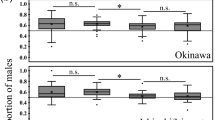Summary:
Whereas hymenopteran societies comprise an overwhelming majority of females, both sexes play basically equal roles in termite societies. However, many termite taxa display, to a variable extent, sexual dimorphism or sexual specialization among the altruistic castes (soldiers and workers). Both sexes are diploid in termites, but actual sex determination mechanisms are not completely understood, although males commonly appear as heterogametic. A frequent feature of male meiosis is the formation of rings or chains in which up to 50-60% of the chromosomes may be involved. A large fraction of the genome is therefore transmitted to all same-sex siblings. A simple model developed here shows that the resulting asymmetries in genetical relatedness between nestmates may exert an influence on reproductive strategies. For instance, different patterns of relatedness asymmetries may result from reproductive replacement and favour skewed sex allocation, especially when altruistic castes are strongly sex-biased themselves. The present model provides a theoretical frame to investigate sex allocation patterns that occur in nature and sometimes strongly deviate from equity.
Similar content being viewed by others
Author information
Authors and Affiliations
Additional information
Received 18 January 2001; revised 19 March 2001; accepted 28 March 2001.
Rights and permissions
About this article
Cite this article
Roisin, Y. Caste sex ratios, sex linkage, and reproductive strategies in termites. Insectes soc. 48, 224–230 (2001). https://doi.org/10.1007/PL00001770
Issue Date:
DOI: https://doi.org/10.1007/PL00001770




